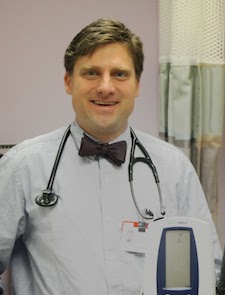 |
|
| Stephen Martin, MD |
Dramatic early findings from a major National Institutes of Health study appear to show significant cardiovascular benefits from lowering the recommended systolic blood pressure for adults over age 50 who are at elevated risk for heart disease, but some primary care doctors at UMass Medical School say they are taking a cautionary approach before making any changes with their patients.
““I would want to know the full details of the study before changing my clinical practic,” said Stephen Martin, MD, assistant professor of family medicine & community health. “Seeing a small sense of what led to the NIH’s suspending the study gives us a glimmer of what’s possible, but we don’t really know the whole picture.”
The Systolic Blood Pressure Intervention Trial (SPRINT) was launched to determine whether adjusting the dosage, number and types of blood pressure medication to achieve a target systolic pressure of 120 millimeters of mercury (mm Hg) rather than the currently recommended 140 mm Hg reduces the risk of cardiovascular disease. The study was scheduled to end in 2018 but the NIH announced that it is halting it in order to release early data.
The NIH expects to publish the full results later this year.
“The idea we should exercise caution before acting on unpublished data is an important message to get out there,” said Ronald Adler, MD, associate professor of family medicine & community health.
Findings thus far in the trial’s high-risk population—all are hypertensive and many have already had heart attacks—indicate that patients who were treated for high blood pressure with the goal of reaching a systolic blood pressure goal below 120 had reductions in their 10-year risk of heart attacks, heart failure and strokes, as compared to subjects whose target systolic pressure was the currently recommended 140 mm Hg. Risk is assessed with several widely accepted calculators.
“I would be interested to know the actual systolic blood pressures achieved in each arm of the study, and the distribution of participants among the various high risk enrollment criteria,” said Dr. Martin. “We also don't know the potential harms from this approach.”
A potential guideline goal of less than 120 mm Hg might lead to consideration of antihypertensive medication for the approximately three out of four adults in the United States whose systolic blood pressure is higher. But UMass family physicians will continue to evaluate a patient’s individual risk and participate in shared decision making with each patient about various interventions, including non-drug options such as increasing physical activity and giving up tobacco, rather than striving to achieve a set point for all.
“From the primary care perspective, nothing changes without seeing the paper and maybe seeing it verified,” said Frank Domino, MD, professor of family medicine & community health.
Rather than automatically prescribing one, two or more medications for patients whose systolic blood pressure is above 120, Drs. Martin, Adler and Domino will continue to assess each patient’s individual risk profiles for cardiovascular disease and share decision making with the patient as to what interventions are appropriate and in accord with their patient’s personal values and preferences.
“We’re the only developed health care system that does not use a risk-based approach to deciding about blood pressure treatment for different people presenting with different levels of risk,” Martin noted. “It means that if you’re age 32 with BP 144/90, you’ll get the same approach as someone with the same blood pressure who is 62 years old and is smoking and has family history of heart disease.”
Beyond primary prevention for those patients with elevated risk but no prior cardiovascular events, Martin also emphasized the greater unmet need for secondary prevention, including cardiac rehabilitation, smoking cessation and adequate lipid control, for individuals who have previously experienced a heart attack, heart failure or stroke.
“We know from a long line of data that for people who’ve had a heart attack or stroke and need secondary prevention, their blood pressure should be below about 140/90, and yet half aren’t there,” he noted. “Those people have a much higher risk of another event than the lower-risk population being treated for primary prevention. I think it gets back to not striving for a universal number whether you’re 23 years old with a SBP of 140, or aged 55 with a history of three heart attacks.”
Related links on UMassMedNow:
UMMS family doctors say many take blood pressure meds not shown to help
Family doctors cautious about new guidelines to prevent heart disease, favor lifestyle changes over more drugs
UMMS primary care physician explains ACA changes in 2014